Medieval History
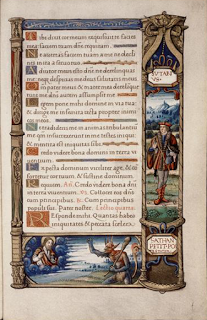
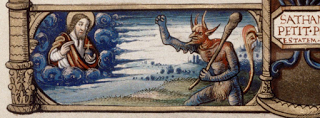 Book of Hours, folio #: fol. 078r, second quarter of 16th century, French. Shelfmark: MS. Douce 135 Bodleian Library, University of Oxford. "Sutarius", richly dressed youth. Below: Satan and God discuss Job.
Book of Hours, folio #: fol. 078r, second quarter of 16th century, French. Shelfmark: MS. Douce 135 Bodleian Library, University of Oxford. "Sutarius", richly dressed youth. Below: Satan and God discuss Job.
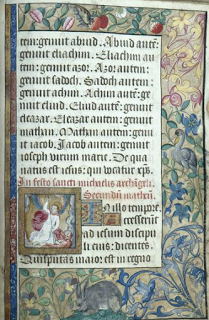
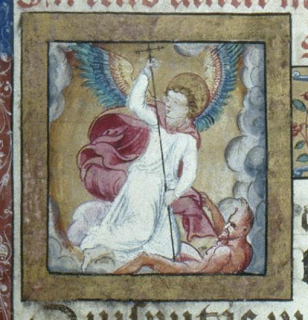 Gospel Lectionary, Pericope, miniature, column fol. 161r, French, c. 1500-1520. Archangel Michael is transfixing Satan, gospel reading from Matthew 18:1 on Feast of Archangel Michael. Princeton: Library, University, Garrett 33.
Gospel Lectionary, Pericope, miniature, column fol. 161r, French, c. 1500-1520. Archangel Michael is transfixing Satan, gospel reading from Matthew 18:1 on Feast of Archangel Michael. Princeton: Library, University, Garrett 33.
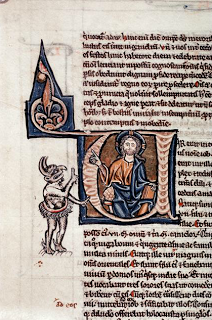
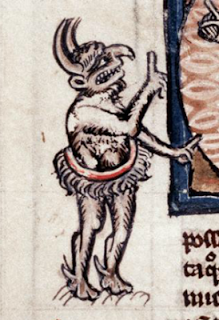 William de Brailes, 'The de Brailes Bible,' folio #: fol. 168v. 13th century, second quarter, made in Oxford, England. God and Satan discuss Job. Bodleian Library, University of Oxford.
William de Brailes, 'The de Brailes Bible,' folio #: fol. 168v. 13th century, second quarter, made in Oxford, England. God and Satan discuss Job. Bodleian Library, University of Oxford.
Interesting to note that William de Brailes was the first English lay illuminator whose name is known.
 Gospels (215 fols.), fol. 131, illustration of "I beheld Satan as lightning falling from heaven'' (Luke 10:18). Byzantine, Constantinople mid 11th century. Now in Paris, Bibliothèque nationale., Département des Manuscrits, MS. Gr. 74.
Gospels (215 fols.), fol. 131, illustration of "I beheld Satan as lightning falling from heaven'' (Luke 10:18). Byzantine, Constantinople mid 11th century. Now in Paris, Bibliothèque nationale., Département des Manuscrits, MS. Gr. 74.
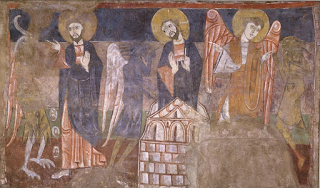 Hermitage of San Baudelio de Berlanga, province of Soria, Spain. The Temptation of Christ, ca. 1125. The hermitage of San Baudelio de Berlanga was constructed in the beginning of the eleventh century at the heart of the frontier between Islamic and Christian lands. One hundred fifty years later, its extraordinary palm-vaulted interior was transformed with the addition of two cycles of vibrant paintings: an extensive Christological cycle at the top and scenes of hunting and animals at the bottom, derived from Islamic art. The large figures of the biblical cycle, the clear outlines, and the radiant colors ensured that the story would be legible from the floor. The fresco conflates three episodes from Christ's Temptation. At the left, the Devil dares Christ to turn stones into bread. In the middle, Satan challenges Christ, standing on the gable of the Temple, to throw himself down. The angel talking to a demon at the right refers to the last temptation of Christ, who, after refusing to worship the Devil, is ministered by angels.
Hermitage of San Baudelio de Berlanga, province of Soria, Spain. The Temptation of Christ, ca. 1125. The hermitage of San Baudelio de Berlanga was constructed in the beginning of the eleventh century at the heart of the frontier between Islamic and Christian lands. One hundred fifty years later, its extraordinary palm-vaulted interior was transformed with the addition of two cycles of vibrant paintings: an extensive Christological cycle at the top and scenes of hunting and animals at the bottom, derived from Islamic art. The large figures of the biblical cycle, the clear outlines, and the radiant colors ensured that the story would be legible from the floor. The fresco conflates three episodes from Christ's Temptation. At the left, the Devil dares Christ to turn stones into bread. In the middle, Satan challenges Christ, standing on the gable of the Temple, to throw himself down. The angel talking to a demon at the right refers to the last temptation of Christ, who, after refusing to worship the Devil, is ministered by angels.
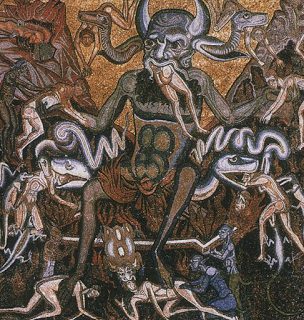 Coppo de Marcovald, Last Judgment, late 13th century, Baptistery of St. Giovanni in Florence, dome mosaic detail: Satan swallows the damned.
Coppo de Marcovald, Last Judgment, late 13th century, Baptistery of St. Giovanni in Florence, dome mosaic detail: Satan swallows the damned.
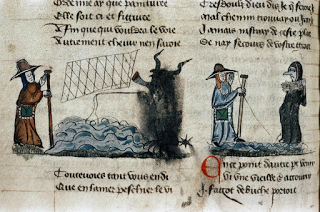 Guillaume de Deguilleville, Le Pèlerinage de la vie humaine, folio #: fol. 103v. French, c. 1400. Bodleian Library, University of Oxford. The pilgrim meets Satan, fishing for souls in the sea of life, while the hag Heresy hurries past.
Guillaume de Deguilleville, Le Pèlerinage de la vie humaine, folio #: fol. 103v. French, c. 1400. Bodleian Library, University of Oxford. The pilgrim meets Satan, fishing for souls in the sea of life, while the hag Heresy hurries past.
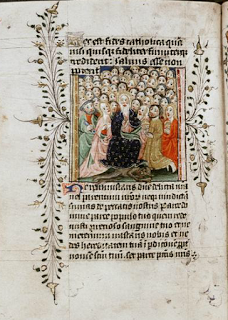
 English illuminated manuscript circa 1433, painted in the style of Herman Scheerre. Shelfmark: MS. Douce 18, Bodleian Library, University of Oxford. The Litany, miniature. God seated, one hand raised in blessing, other holding orb, Satan at His feet. He is surrounded by saints, no haloes, but some with attributes. The Virgin(?) on His right, St. Peter with key beside her. On opposite end, Mary Magdalen with her ointment jar.
English illuminated manuscript circa 1433, painted in the style of Herman Scheerre. Shelfmark: MS. Douce 18, Bodleian Library, University of Oxford. The Litany, miniature. God seated, one hand raised in blessing, other holding orb, Satan at His feet. He is surrounded by saints, no haloes, but some with attributes. The Virgin(?) on His right, St. Peter with key beside her. On opposite end, Mary Magdalen with her ointment jar.
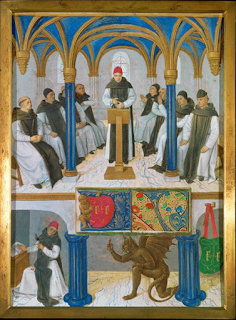
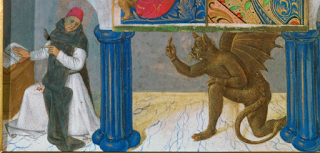 Jean Fouquet, Hours of Étienne Chevalier; Saint Bernard Praying with His Monks [top], Saint Bernard Tempted by Satan [bottom], c. 1455, Musée Condé, Ms.fr.71
Jean Fouquet, Hours of Étienne Chevalier; Saint Bernard Praying with His Monks [top], Saint Bernard Tempted by Satan [bottom], c. 1455, Musée Condé, Ms.fr.71
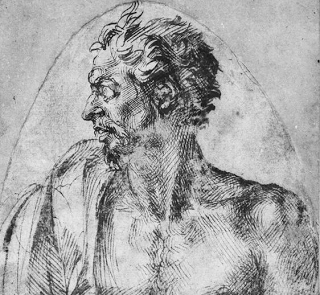 Michelangelo Buonarroti, Head and shoulders of a satyr/Satan, the head in profile to left. 1501-1503. The demented gaze and horn-like flowing hair of this figure provided its traditional description as Satan. Wilde preferred to describe it as a satyr, satyrs being the attendants of Bacchus from whom they derived their goat-like features.
Michelangelo Buonarroti, Head and shoulders of a satyr/Satan, the head in profile to left. 1501-1503. The demented gaze and horn-like flowing hair of this figure provided its traditional description as Satan. Wilde preferred to describe it as a satyr, satyrs being the attendants of Bacchus from whom they derived their goat-like features.
I know this is not medieval or 'in the details,' but I'm interested in the Bacchus-satyr-Satan iconographic connection, and this work highlights that rather nicely.
- Cfp: Denizens Of Hell: Devils, Demons And The Damned
CALL FOR PAPERS 45th International Congress on Medieval Studies (May 13?16, 2010) Special Session Denizens of Hell: Devils, Demons and the Damned In past years a number of sessions have been arranged on the devil, demons, and the damned in the middle...
- Medieval Medical Treatises
My five-year-old burned her leg on my curling iron today. I only asked her five times to give me some space in the bathroom BEFORE she knocked the curling iron onto her leg, but whatevs. After I cleaned her up and she was properly bandaged, she was impressed...
- 'monokeros,' Or Unicorns In Imagery And Myth, Ii
Relief showing a Stag and Unicorn, ca. 950, Italian, near Nola. This relief from a church in Nola (near Naples) formed part of a transenna, a low wall that demarcated the church's presbytery, an area reserved for the clergy. The motif of opposed...
- Eleanor Of Aquitaine
The wedding of Louis VII and Eleanor of Aquitaine, 1137. Grandes Chroniques de France, Folio #: fol. 192r. End of 14th century. Bodleian Library, University of Oxford ...
- Not A Saint - But A Sinner!
Two bright and acute thinkers put forth that the woman in the last post is not a saint - but one of the Bible's most infamous sinners: Bathsheba. But our Bathsheba would be a most demure temptress, fully clothed as she is. She must have had...
Medieval History
The devil in the details






Interesting to note that William de Brailes was the first English lay illuminator whose name is known.









I know this is not medieval or 'in the details,' but I'm interested in the Bacchus-satyr-Satan iconographic connection, and this work highlights that rather nicely.
- Cfp: Denizens Of Hell: Devils, Demons And The Damned
CALL FOR PAPERS 45th International Congress on Medieval Studies (May 13?16, 2010) Special Session Denizens of Hell: Devils, Demons and the Damned In past years a number of sessions have been arranged on the devil, demons, and the damned in the middle...
- Medieval Medical Treatises
My five-year-old burned her leg on my curling iron today. I only asked her five times to give me some space in the bathroom BEFORE she knocked the curling iron onto her leg, but whatevs. After I cleaned her up and she was properly bandaged, she was impressed...
- 'monokeros,' Or Unicorns In Imagery And Myth, Ii
Relief showing a Stag and Unicorn, ca. 950, Italian, near Nola. This relief from a church in Nola (near Naples) formed part of a transenna, a low wall that demarcated the church's presbytery, an area reserved for the clergy. The motif of opposed...
- Eleanor Of Aquitaine
The wedding of Louis VII and Eleanor of Aquitaine, 1137. Grandes Chroniques de France, Folio #: fol. 192r. End of 14th century. Bodleian Library, University of Oxford ...
- Not A Saint - But A Sinner!
Two bright and acute thinkers put forth that the woman in the last post is not a saint - but one of the Bible's most infamous sinners: Bathsheba. But our Bathsheba would be a most demure temptress, fully clothed as she is. She must have had...
